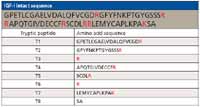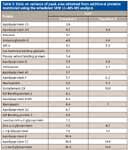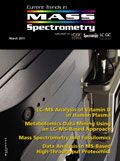Time-Resolved SRM Analysis and Highly Multiplexed LC–MS-MS for Quantifying Tryptically Digested Proteins
Special Issues
The inclusion of time-resolved selected reaction monitoring (SRM) functionalities into mass spectrometer control software allows large numbers of peptides to be quantified using short LC–MS-MS methods.
The commercialization of high-pressure liquid chromatography (LC) systems, in combination with sub-2-µm particle high performance liquid chromatography (HPLC) columns, has enabled scientists to generate highly efficient LC–tandem mass spectrometry (MS-MS) methods for separating peptides in complex matrices. The ability to reliably quantify a single peptide with baseline peak widths of ~4.5 s is relatively simple; however, this becomes significantly more challenging when performing highly multiplexed selected reaction monitoring (SRM) analyses. Long duty cycles involved in multiplexed analyses can severely impact the ability to acquire sufficient data points over a peptide peak. The inclusion of time-resolved SRM functionalities into the mass spectrometer control software has resolved this issue, where large numbers of peptides can now be quantified using short LC–MS-MS methods. The benefits of time-resolved SRM analyses are discussed, along with examples of LC–MS-MS applications.
Mass spectrometry (MS), in combination with separation techniques such as gas chromatgraphy (GC)and liquid chromatography (LC), has been used to quantify small molecules in biological matrices for decades. The application of electrospray ionization (ESI) has enabled the same instrumentation to detect and analyse peptides and proteins in combination with LC. Protein analysis is simplified through the addition of proteolytic enzymes, which cleave the protein at specific amino acid residues, converting the protein into smaller, more manageable peptide fragments. The most commonly used protease is trypsin, which cuts the peptide backbone at the C-terminal side of lysine (K) and arginine (R) residues (except immediately prior to proline [P]).
The enzymatic digestion of a protein can generate a large number of surrogate peptides, which significantly increases the complexity of the matrix; however, it also enables analysts to monitor multiple peptides from the same protein. Furthermore, other proteins present in the same matrix will also be digested into respective peptides, therefore enabling a multiplexed protein analysis. Some laboratories have used LC–MS-MS and selected reaction monitoring (SRM)-based analysis to monitor significant numbers of analytes, such as Anderson and Hunter (1), who used 137 SRM transitions to monitor 53 proteins in a single experiment. This work involved the use of a nanobore LC system, which gave excellent sensitivity. However, each analysis had a run time in excess of 40 min. For LC–MS-MS to be used routinely for protein analysis of clinical samples, the run time must be reduced significantly. Using a 40-min run time will allow a throughput of 36 analyses per day; however, if a runtime of 4 min was achieved, the throughput would increase to 360 analyses. This reduction in time has been demonstrated by using high-flow-rate systems, with a concomitant drop in sensitivity that would be expected moving from nano to normal flow rates (2).
One additional drawback from moving to higher flow rates is that the multiplexing capability is severely reduced because of the need to obtain in excess of 12 points over a chromatographic peak. This article describes advances in both LC and MS instrumentation that have facilitated the development of highly multiplexed analyses that can be performed using short run times.
Ultrahigh-Pressure Liquid Chromatography
Recent developments in both LC instrumentation and stationary phase particle sizes have significantly improved the ability to separate and detect peptides within digests of complex matrices such as plasma. The development of ultrahigh-pressure capable systems has enabled the use of sub-2-µm particles within LC columns. Using sub-2-µm particle columns enables analysts to generate peptide peak widths in the region of 1 s at half height, giving significant improvements in peptide resolution compared to both normal high performance liquid chromatography (HPLC) separations, and nanobore separations (2). This peak sharpening has resulted in increases in sensitivity over normal HPLC, as the peptides are eluted in a smaller volume in the electrospray ionization (ESI) source.
The ability to generate sharp peptide peaks is not limited to sub-2-µm particles, as high resolution peptide separations have also been achieved using fused-core columns (3). Fused-core particles have an impermeable core with a diameter of 1.7 µm and a 0.5-µm layer of porous solid phase material bonded to the surface of the particle. These columns generate almost identical separation characteristics as the sub-2-µm particle columns; however, the loadability of the column is lower because of the reduction in solid-phase material available for performing separations.
Impact of Improved Peptide Separation on Multiplexed Analyses
The ability to generate very sharp peptide peaks has resulted in an overall increase in sensitivity, but it also has reduced the ability to perform multiplexed analyses. The ability to collect significant numbers (more than 15) of data points over a peak is reduced when large numbers of SRM transitions are being monitored using a normal LC–MS-MS method. An example analysis involved monitoring 12 SRM transitions over a 5-min analysis, where one particular peptide peak was a total of 4.5 s wide at baseline (Figure 1a). Each SRM transition was monitored for a total of 30 ms, resulting in a duty cycle time totaling 420 ms (including the mandatory 5-ms settling time between SRM transitions). For this particular peptide with a peak width of 4.5 s at baseline, a duty cycle of 420 ms will result in a total of 11 data points over the peak. Reducing the dwell time for each transition to 15 ms will increase the number of points over the peak from 11 to 19; however, reducing dwell times can introduce increased variability of measurement. Also, if a user needs to increase the number of SRM transitions being monitored, then the duty cycle time becomes an issue again.

Figure 1: (a) Normal SRM analysis of an IGF-Iâderived peptide in which 12 transitions are being monitored, each with a 30-ms dwell time. (b) Introduction of a method split, where five SRM transitions were monitored in this specific time window. (c) Time-resolved SRM analysis in which the SRM for the IGF-I peptide was being monitored over a 20-s window.
A standard approach for improving the number of points over a peak for multiplexed analyses is to introduce periods into the methodology in which specific SRM transitions are monitored for a predefined time before the method changes to scan for a completely different set of SRM transitions. Using these periods can improve the number of points over a peak (Figure 1b), but setting the position of the periods within a method can be problematic — especially if large numbers of peptides are being monitored — because finding a clear stretch of chromatogram can be difficult. Furthermore, if the chromatographic separation changes over time, the position of the method splits could result in the loss of peptide information. Therefore, the positions of the periods must be carefully identified such that loss of information is minimized.

Figure 2: Amino acid sequence of IGF-I and the sequences of peptides generated upon tryptic cleavage of the protein. Cleavage sites are indicated by red text in the intact IGF-I sequence.
Time-Resolved SRM Methodologies
Instrument manufacturers have addressed the problem of performing highly multiplexed analyses and the issue of obtaining significant numbers of points over a chromatographic peak. To resolve the issue of long cycle times for highly multiplexed analyses, an option to perform SRM acquisition in a time-resolved fashion has been built into the control software. Examples of this feature are the Scheduled MRM function that is integrated into Analyst software from AB Sciex (Foster City, California) and the iSRM function that is integrated into Xcalibur software from Thermo Fisher Scientific (Huntington Beach, California). Essentially this time-resolved functionality enables users to specify the retention time of their analyte and to set a nominal time window over which the SRM transition is to be monitored. The control software then adds or subtracts the SRM transitions being monitored at any given time during the analytical run, dependent on the user-specified retention times for peptides of interest. This functionality, combined with highly robust retention times from high-flow-rate LC systems, enables users to monitor significantly higher numbers of SRM transitions without the prohibitively high cycle times. More importantly, using this functionality enables sufficient points over a peak to be obtained for high quality quantitative analyses. A comparison of a normal, periodic, and time-resolved SRM analysis is shown in Figures 1a, 1b, and 1c, respectively, where the most data points over a peak were obtained using a time-resolved SRM analysis.

Table I: Additional proteins monitored using time-resolved SRM analysis
Case Studies Using Time-Resolved SRM Analysis
Quantitation of IGF-I, and other clinically relevant proteins in serum: A time-resolved SRM analysis method was developed to quantify insulin-like growth factor-I (IGF-I) in human serum, along with a large number of other clinically relevant plasma proteins. IGF-I is a 70-amino-acid, 7.6-kDa protein (Figure 2) that is present in plasma at a concentration of approximately 100 ng/mL. The protein is a direct biomarker of growth hormone (GH) and is used to clinically diagnose disorders in GH production, such as acromegaly (excess of GH) and GH deficiency. Tryptic digestion of the protein yields eight peptides of varying lengths ranging from two single arginine residues (T3 and T6) to 21 amino acids (T1) (Figure 2). Following initial method development, two peptides were selected for analysis (T1 and T4) totaling 49% of the entire protein sequence. Two suitable SRM transitions were identified for the T1 peptide and one for the T4 peptide, and equal numbers of transitions were used for their stable-isotope-labeled peptide equivalents for use as internal standards (totaling six transitions for the two peptides). A further 37 transitions were monitored, targeting 24 additional proteins (Table I). An example chromatogram from the LC–MS-MS analysis is displayed in Figure 3.

Figure 3: Example chromatogram monitoring 43 transitions for 25 plasma proteins, ranging in concentration from 50 mg/mL (albumin) to 100 ng/mL (IGF-I).
An eight-point standard addition calibration line of IGF-I was generated in human serum from 25 to 4000 ng/mL along with four aliquots of the same blank serum. Serum was treated with acid and extracted using a mixed-mode solid-phase extraction (SPE) material (Plexa, Varian, Inc., Palo Alto, California). Tryptic digestion was performed after reduction and alkylation of the extract, and the samples were analyzed using LC–MS-MS and a scheduled SRM method as described above. The standard addition calibration line obtained for IGF-I from the analysis showed good linearity with an r 2 of 0.9970 (Figure 4), and all calibration standards were within the �15% and �20% relative error values required for bioanalytical validation of small molecules. The peak areas obtained from the peptides from the 24 additional proteins were calculated for the eight calibration samples and four blanks (n = 12), and the results are displayed in Table II. The highest variance observed was 16.5% CV from the protein α-1-acid glycoprotein, whereas the lowest variance was seen for apolipoprotein C3, with a CV of 3.8%. These results demonstrate the reproducibility of the extraction methodology, the tryptic digestion step, and the LC–MS-MS analysis, especially because no internal standardization has been performed on the peptide peak area data.

Figure 4: Standard addition curve of IGF-I spiked into human serum and analyzed using a scheduled SRM-based LCâMS-MS methodology.
A possible application for this type of LC–MS-MS assay would be a clinical laboratory to quantify concentrations of plasma proteins. The introduction of an LC–MS-MS method for high level plasma proteins could involve significant cost reductions, because large numbers of proteins could be quantified in a single analysis instead of using separate immunological-based assays for each individual protein.

Table II: Data on variance of peak area obtained from additional proteins monitored using the scheduled SRM LCâMS-MS analysis
Identification of proteotypic peptides for a therapeutic monoclonal antibody:Therapeutic monoclonal antibodies are being used increasingly to treat specific diseases. They consist of four protein subunits, two heavy chains and two light chains, the majority of which display high degrees of similarity to their endogenous immunoglobulin equivalents. Immunoglobulins are present in plasma in concentrations of approximately 10 mg/mL, which equates to roughly 1% of plasma (w/v) and 10% of the total plasma protein content (4). The main reason for the similarity is to prevent the body's natural defenses from seeing the monoclonal antibody as a foreign protein and eliciting an immune response. These high degrees of similarity make quantitation of the monoclonal antibody using an immunological technique significantly more complicated, because the detection antibody would need to be extremely specific to detect only the therapeutic antibody in the presence of endogenous antibodies.
The high specificity of an LC–MS-MS approach simplifies the quantitation of monoclonal antibodies in plasma as long as one or more proteotypic peptides can be identified. Proteotypic peptides can be identified by screening digested extracts from large numbers of individual plasmas using SRM transitions specific for the monoclonal antibody. The application of a time-resolved approach can significantly increase the number of peptides monitored per analysis. Furthermore, the target analyte for the therapeutic antibody can also be monitored, enabling the LC–MS-MS method to be used for both pharmacokinetic and pharmacodynamic analyses (Figure 5). In this example, a total of 81 SRM transitions were monitored that targeted 16 peptides, eight from the monoclonal antibody and eight from the target protein, all within a 5-min LC–MS-MS method.

Figure 5: Example chromatogram of a tryptically digested mixed standard of a therapeutic monoclonal antibody and its target protein. The analysis consisted of 81 SRM transitions; however, only data on the most intense transition for each peptide is displayed for clarity.
The result of the screening process was that only a single peptide was found to be specific for the monoclonal antibody out of the eight targeted from the hypervariable region of the protein. This peptide was then used to develop a quantitative LC–MS-MS method for the monoclonal antibody in human serum. The fact that seven of the eight proteins from the hypervariable region of the protein were detected in normal serum highlights the degree of homology between therapeutic monoclonal antibodies and the immunoglobulins already present in plasma. This further demonstrates the difficulty in developing immunological-based methodology to quantify monoclonal antibodies, as the protein drug will essentially have the same structure as the endogenous immunoglobulins.
Conclusions
Improvements in HPLC column particle designs and the availability of next-generation LC instrumentation have enabled significant improvements in peptide separations. This has resulted in the ability to generate highly efficient peptide separations with extremely sharp peaks. However, the significant improvements in peak width have essentially rendered existing MS instrumentation and control software unsuitable for highly multiplexed analyses due to its inability to collect sufficient data points over a peptide peak. Innovations in SRM-based LC–MS-MS approaches have led to the development of time-resolved SRM acquisition functions. Examples were shown that demonstrated how time-resolved SRM analysis with modern LC–MS-MS systems enables highly multiplexed and high-throughput protein analyses. This technique has helped MS users to obtain sufficient points over a peak in highly multiplexed peptide analyses and consequently to generate high quality quantitative methods.
Richard G. Kay, James W. Howard, and Steve Pleasance are with Quotient Bioresearch Ltd., Fordham, United Kingdom.
References
(1) N.L. Anderson and C.L. Hunter, Mol. Cell. Proteomics 5, 573–588 (2006).
(2) R.G. Kay, B. Gregory, P.B. Grace, and S. Pleasance, Rapid Commun. Mass Spectrom. 21, 2585–2593 (2007).
(3) C. Barton, R.G. Kay, W. Gentzer, F. Vitzthum, and S. Pleasance, J. Proteomics Res. 9, 333–340 (2010).
(4) N.L. Anderson and N.G. Anderson, Mol. Cell. Proteomics 11, 845–867 (2002).

Accelerating Monoclonal Antibody Quality Control: The Role of LC–MS in Upstream Bioprocessing
This study highlights the promising potential of LC–MS as a powerful tool for mAb quality control within the context of upstream processing.
Using GC-MS to Measure Improvement Efforts to TNT-Contaminated Soil
April 29th 2025Researchers developing a plant microbial consortium that can repair in-situ high concentration TNT (1434 mg/kg) contaminated soil, as well as overcome the limitations of previous studies that only focused on simulated pollution, used untargeted metabolone gas chromatography-mass spectrometry (GC-MS) to measure their success.
Prioritizing Non-Target Screening in LC–HRMS Environmental Sample Analysis
April 28th 2025When analyzing samples using liquid chromatography–high-resolution mass spectrometry, there are various ways the processes can be improved. Researchers created new methods for prioritizing these strategies.
Potential Obstacles in Chromatographic Analyses Distinguishing Marijuana from Hemp
April 28th 2025LCGC International's April series for National Cannabis Awareness Month concludes with a discussion with Walter B. Wilson from the National Institute of Standard and Technology’s (NIST’s) Chemical Sciences Division regarding recent research his team conducted investigating chromatographic interferences that can potentially inflate the levels of Δ9-THC in Cannabis sativa plant samples, and possible solutions to avoid this problem.

.png&w=3840&q=75)

.png&w=3840&q=75)



.png&w=3840&q=75)



.png&w=3840&q=75)










